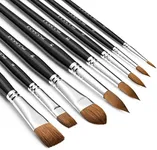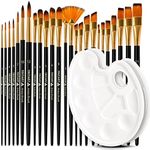Buying Guide for the Best Watercolor Brushes
Choosing the right watercolor brushes can make a big difference in your painting experience and results. The right brush will help you control the paint, achieve the effects you want, and enjoy the process more. When picking watercolor brushes, it's important to consider how you like to paint, the types of subjects you work on, and your comfort with different brush shapes and sizes. Understanding the key features of watercolor brushes will help you select the best ones for your needs.Brush ShapeBrush shape refers to the form of the brush tip, such as round, flat, filbert, or mop. This is important because each shape creates different marks and effects. Round brushes are versatile and good for detail and washes, flat brushes are great for bold strokes and filling large areas, filbert brushes offer a blend of round and flat characteristics, and mop brushes hold a lot of water for broad washes. To choose the right shape, think about the style of painting you enjoy—if you like detailed work, start with round brushes; for large, loose washes, try mop or flat brushes.
Brush SizeBrush size is usually indicated by a number, with smaller numbers for finer, smaller brushes and larger numbers for bigger brushes. This matters because the size affects how much paint and water the brush can hold and the width of the strokes you can make. Small brushes (sizes 0–4) are best for detail work, medium brushes (sizes 6–10) are good for general painting, and large brushes (sizes 12 and up) are ideal for washes and covering big areas. Choose sizes based on the scale of your artwork and the level of detail you want to achieve.
Bristle MaterialBristle material can be natural (like sable or squirrel) or synthetic. This is important because it affects how the brush holds water and paint, as well as its springiness and durability. Natural hair brushes usually hold more water and paint, making them great for smooth washes, while synthetic brushes are often more affordable and durable, with good snap for detail work. If you want soft, flowing washes, natural hair might suit you; if you prefer crisp lines or want a vegan option, synthetic is a good choice.
Brush Handle LengthHandle length can be short or long, and this affects comfort and control. Short handles are common for watercolor brushes because they allow for better control when working close to the paper, which is typical in watercolor painting. Long handles are more common in other types of painting where you might stand back from the canvas. If you paint at a desk or table, short handles are usually more comfortable and practical.
Brush Point and SnapThe point refers to how well the brush tip comes to a fine end, and snap is how quickly the bristles return to their original shape after being bent. These qualities are important for precision and control, especially in detailed work. A good point helps with fine lines and details, while good snap makes the brush responsive and easier to control. If you do a lot of detail work, look for brushes with a sharp point and good snap; for loose washes, these qualities are less critical.


















